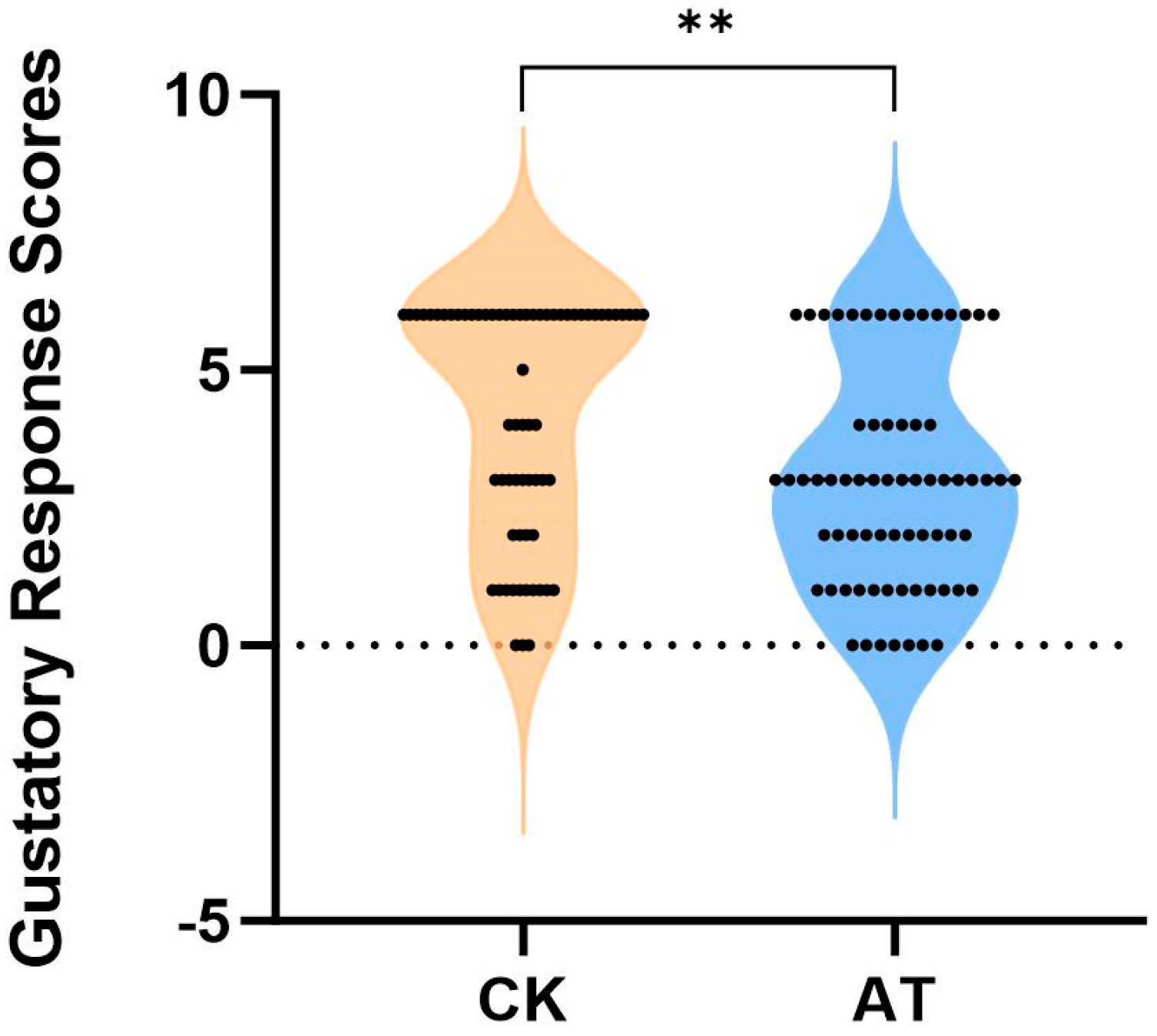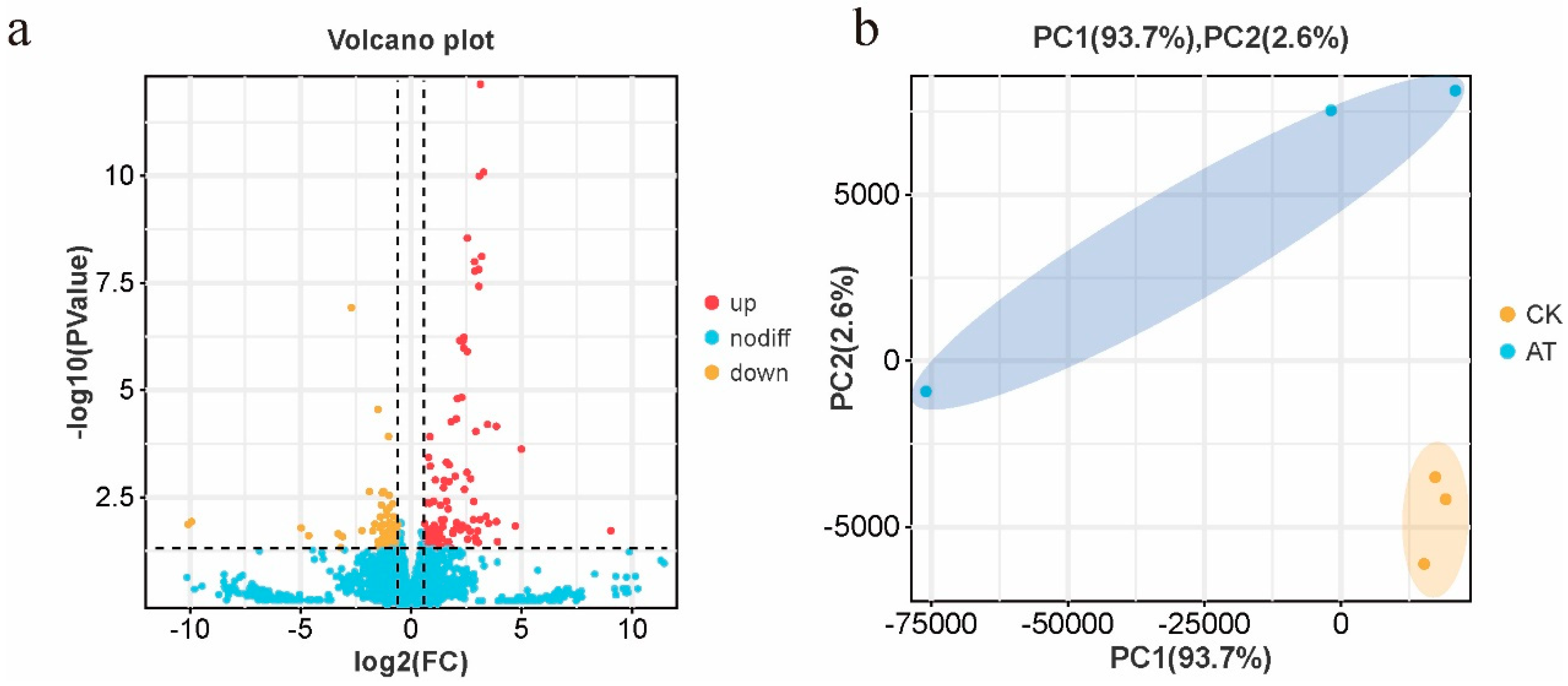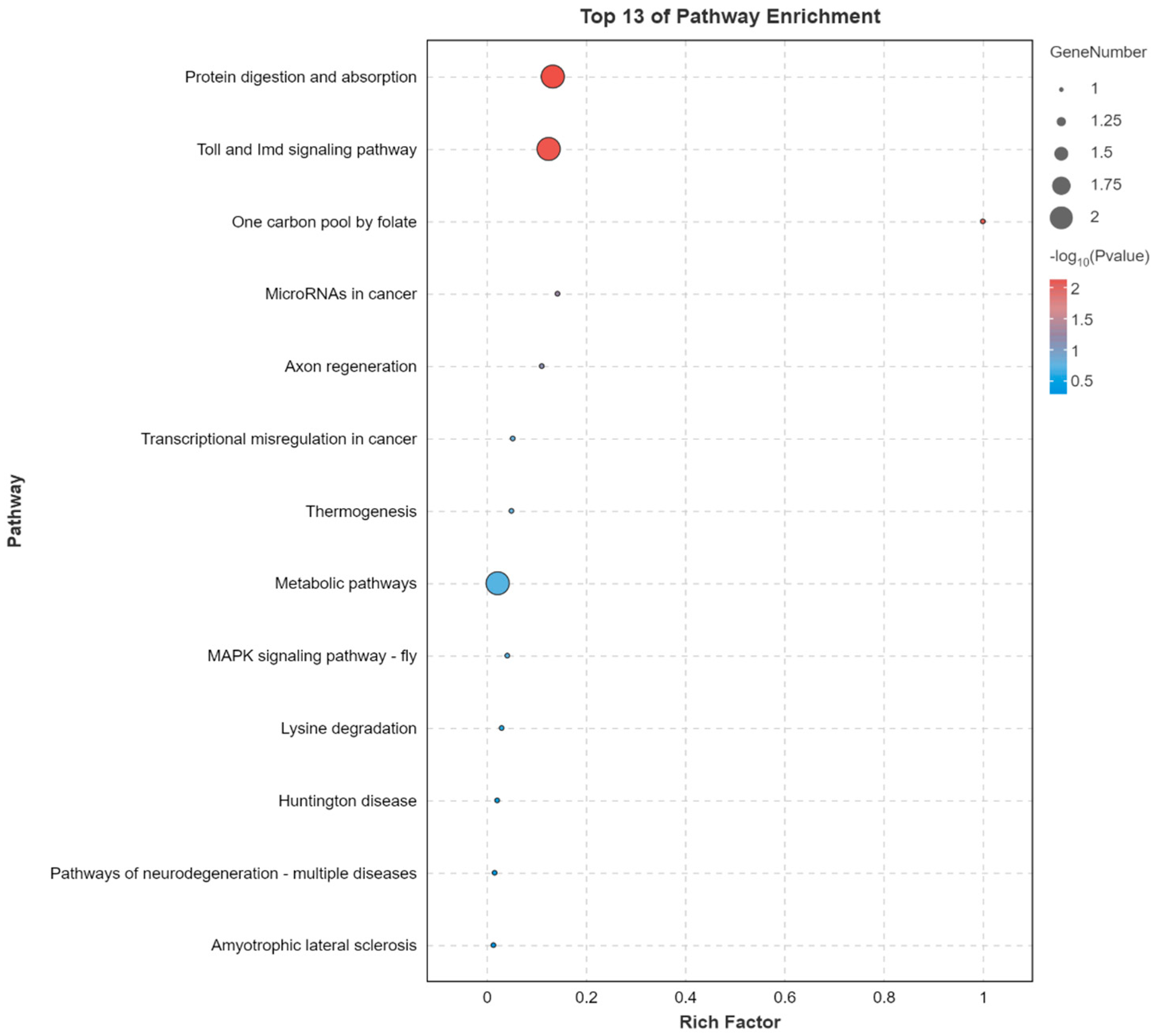Impact of Atrazine on Sucrose Sensitivity in Honey Bees
Simple Summary
Abstract
1. Introduction
2. Materials and Methods
2.1. Honey Bees and Atrazine Preparation
2.2. Proboscis Extension Response (PER) Experiment
2.3. Brain Gene Expression Analysis
2.4. Statistical Analysis
3. Results
3.1. Atrazine Reduces Sucrose Sensitivity in Honey Bees
3.2. Atrazine Changes the Functional Gene Expression in Honey Bee Brain
4. Discussion
5. Conclusions
Supplementary Materials
Author Contributions
Funding
Data Availability Statement
Conflicts of Interest
Abbreviations
| PER | Proboscis extension response |
| DEG | Differentially expressed gene |
| KEGG | Kyoto Encyclopedia of Genes and Genomes |
References
- Hung, K.L.J.; Kingston, J.M.; Albrecht, M.; Holway, D.A.; Kohn, J.R. The worldwide importance of honey bees as pollinators in natural habitats. Proc. Roy. Soc. B 2018, 285, 20172140. [Google Scholar] [CrossRef] [PubMed]
- Pervez, M.; Manzoor, F. Honey bee losses and pesticides threat: An Asian perspective. J. Apic. Res. 2023, 62, 64–75. [Google Scholar] [CrossRef]
- Sgolastra, F.; Medrzycki, P.; Bortolotti, L.; Maini, S.; Porrini, C.; Simon-Delso, N.; Bosch, J. Bees and pesticide regulation: Lessons from the neonicotinoid experience. Biol. Conserv. 2020, 241, 108356. [Google Scholar] [CrossRef]
- Barbosa, W.F.; Smagghe, G.; Guedes, R.N.C. Pesticides and reduced-risk insecticides, native bees and pantropical stingless bees: Pitfalls and perspectives. Pest Manag. Sci. 2015, 71, 1049–1053. [Google Scholar] [CrossRef]
- Smith, A.E.; Muir, D.C.; Grover, R. The triazine herbicides. In Anal of Pest in Water Anal Nitrogen Cont Pest; CRC Press: Boca Raton, FL, USA, 2020; pp. 213–239. [Google Scholar]
- Stradtman, S.C.; Freeman, J.L. Mechanisms of neurotoxicity associated with exposure to the herbicide atrazine. Toxics 2021, 9, 207. [Google Scholar] [CrossRef]
- Wang, K.; Cai, M.; Sun, J.; Chen, H.; Lin, Z.; Wang, Z.; Niu, Q.; Ji, T. Atrazine exposure can dysregulate the immune system and increase the susceptibility against pathogens in honeybees in a dose-dependent manner. J. Hazard. Mater. 2023, 452, 131179. [Google Scholar] [CrossRef]
- Marcus, S.R.; Fiumera, A.C. Atrazine exposure affects longevity, development time and body size in Drosophila melanogaster. J. Insect Physiol. 2016, 91, 18–25. [Google Scholar] [CrossRef] [PubMed]
- Figueira, F.H.; de Quadros Oliveira, N.; de Aguiar, L.M.; Escarrone, A.L.; Primel, E.G.; Barros, D.M.; da Rosa, C.E. Exposure to atrazine alters behaviour and disrupts the dopaminergic system in Drosophila melanogaster. Comp. Biochem. Physiol. Part C Toxicol. Pharmacol. 2017, 202, 94–102. [Google Scholar] [CrossRef]
- Henry, B.L.; Wesner, J.S. Severing ties: Different responses of larval and adult aquatic insects to atrazine and selenium. Environ. Sci. Technol. 2018, 52, 8848–8857. [Google Scholar] [CrossRef]
- Schmidel, A.J.; Assmann, K.L.; Werlang, C.C.; Bertoncello, K.T.; Francescon, F.; Rambo, C.L.; Beltrame, G.M.; Calegari, D.; Batista, C.B.; Blaser, R.E. Subchronic atrazine exposure changes defensive behaviour profile and disrupts brain acetylcholinesterase activity of zebrafish. Neurotoxicol. Teratol. 2014, 44, 62–69. [Google Scholar] [CrossRef]
- Khoshdel-Sarkarizi, H.; Hami, J.; Mohammadipour, A.; Sadr-Nabavi, A.; Mahmoudi, M.; Kheradmand, H.; Peyvandi, M.; Nourmohammadi, E.; Haghir, H. Developmental regulation and lateralization of GABA receptors in the rat hippocampus. Int. J. Dev. Neurosci. 2019, 76, 86–94. [Google Scholar] [CrossRef] [PubMed]
- Baradaran, R.; Khoshdel-Sarkarizi, H.; Kargozar, S.; Hami, J.; Mohammadipour, A.; Sadr-Nabavi, A.; Peyvandi Karizbodagh, M.; Kheradmand, H.; Haghir, H. Developmental regulation and lateralisation of the α7 and α4 subunits of nicotinic acetylcholine receptors in developing rat hippocampus. Int. J. Dev. Neurosci. 2020, 80, 303–318. [Google Scholar] [CrossRef] [PubMed]
- Rastegar-Moghaddam, S.H.; Mohammadipour, A.; Hosseini, M.; Bargi, R.; Ebrahimzadeh-Bideskan, A. Maternal exposure to atrazine induces the hippocampal cell apoptosis in mice offspring and impairs their learning and spatial memory. Toxin Rev. 2019, 38, 298–306. [Google Scholar] [CrossRef]
- Genovese, T.; Siracusa, R.; Fusco, R.; D’Amico, R.; Impellizzeri, D.; Peritore, A.F.; Crupi, R.; Gugliandolo, E.; Morabito, R.; Cuzzocrea, S. Atrazine inhalation causes neuroinflammation, apoptosis and accelerating brain aging. Int. J. Mol. Sci. 2021, 22, 7938. [Google Scholar] [CrossRef] [PubMed]
- Helmer, S.H.; Kerbaol, A.; Aras, P.; Jumarie, C.; Boily, M. Effects of realistic doses of atrazine, metolachlor, and glyphosate on lipid peroxidation and diet-derived antioxidants in caged honey bees (Apis mellifera). Environ. Sci. Pollut. Res. 2015, 22, 8010–8021. [Google Scholar] [CrossRef]
- Ramírez, G.P.; Martínez, A.S.; Fernández, V.M.; Corti Bielsa, G.; Farina, W.M. The influence of gustatory and olfactory experiences on responsiveness to reward in the honeybee. PLoS ONE 2010, 5, e13498. [Google Scholar] [CrossRef]
- Zhang, Z.; Mu, X.; Shi, Y.; Zheng, H. Distinct roles of honeybee gut bacteria on host metabolism and neurological processes. Microbiol. Spectr. 2022, 10, e02438-21. [Google Scholar] [CrossRef]
- Centanni, M.; Ricci, G.; De Girolamo, A.; Romano, G.; Gentile, F. A review of modeling pesticides in freshwaters: Current status, progress achieved and desirable improvements. Environ. Pollut. 2023, 316, 120553. [Google Scholar] [CrossRef]
- Caretta, M. Neurobiology of chemical communication. CRC Press: Boca Raton, FL, USA, 2014. [CrossRef]
- Paoli, M.; Giurfa, M. Pesticides and pollinator brain: How do neonicotinoids affect the central nervous system of bees? Eur. J. Neurosci. 2024, 60, 5927–5948. [Google Scholar] [CrossRef]
- Farina, W.M.; Balbuena, M.S.; Herbert, L.T.; Mengoni Goñalons, C.; Vázquez, D.E. Effects of the herbicide glyphosate on honey bee sensory and cognitive abilities: Individual impairments with implications for the hive. Insects 2019, 10, 354. [Google Scholar] [CrossRef]
- Abuagla, M.I.; Iqbal, J.; Raweh, H.S.; Alqarni, A.S. Insight into olfactory learning, memory, and mortality of Apis mellifera jemenitica after exposure to acetamiprid insecticide. Insects 2024, 15, 473. [Google Scholar] [CrossRef]
- Berenbaum, M.R.; Johnson, R.M. Xenobiotic detoxification pathways in honey bees. Curr. Opin. Insect Sci. 2015, 10, 51–58. [Google Scholar] [CrossRef]
- Jin, Y.; Wang, L.; Chen, G.; Lin, X.; Miao, W.; Fu, Z. Exposure of mice to atrazine and its metabolite diaminochlorotriazine elicits oxidative stress and endocrine disruption. Environ. Toxicol. Pharmacol. 2014, 37, 782–790. [Google Scholar] [CrossRef]
- Zhang, C.; Li, X.-N.; Xiang, L.-R.; Qin, L.; Lin, J.; Li, J.-L. Atrazine triggers hepatic oxidative stress and apoptosis in quails (Coturnix C. coturnix) via blocking Nrf2-mediated defense response. Ecotoxicol. Environ. Saf. 2017, 137, 49–56. [Google Scholar] [CrossRef] [PubMed]
- Zhu, L.; Dong, X.; Xie, H.; Wang, J.; Wang, J.; Su, J.; Yu, C. DNA damage and effects on glutathione S-transferase activity induced by atrazine exposure in zebrafish (Danio rerio). Environ. Toxicol. 2011, 26, 480–488. [Google Scholar] [CrossRef] [PubMed]
- Hafez, D.; Huang, J.Y.; Huynh, A.M.; Valtierra, S.; Rockenstein, E.; Bruno, A.M.; Lu, B.; DesGroseillers, L.; Masliah, E.; Marr, R.A. Neprilysin-2 is an important β-amyloid degrading enzyme. Am. J. Pathol. 2011, 178, 306–312. [Google Scholar] [CrossRef]
- Huang, S.-M.; Mouri, A.; Kokubo, H.; Nakajima, R.; Suemoto, T.; Higuchi, M.; Staufenbiel, M.; Noda, Y.; Yamaguchi, H.; Nabeshima, T. Neprilysin-sensitive synapse-associated amyloid-β peptide oligomers impair neuronal plasticity and cognitive function. J. Biol. Chem. 2006, 281, 17941–17951. [Google Scholar] [CrossRef] [PubMed]
- Spencer, B.; Marr, R.A.; Rockenstein, E.; Crews, L.; Adame, A.; Potkar, R.; Patrick, C.; Gage, F.H.; Verma, I.M.; Masliah, E. Long-term neprilysin gene transfer is associated with reduced levels of intracellular Abeta and behavioral improvement in APP transgenic mice. BMC Neurosci. 2008, 9, 109. [Google Scholar] [CrossRef]
- Liu, Y.; Studzinski, C.; Beckett, T.; Guan, H.; Hersh, M.A.; Murphy, M.P.; Klein, R.; Hersh, L.B. Expression of neprilysin in skeletal muscle reduces amyloid burden in a transgenic mouse model of Alzheimer disease. Mol. Ther. 2009, 17, 1381–1386. [Google Scholar] [CrossRef]
- Huang, J.Y.; Hafez, D.M.; James, B.D.; Bennett, D.A.; Marr, R.A. Altered NEP2 expression and activity in mild cognitive impairment and Alzheimer’s disease. J. Alzheimer’s Dis. 2012, 28, 433–441. [Google Scholar] [CrossRef]
- Castells-Nobau, A.; Eidhof, I.; Fenckova, M.; Brenman-Suttner, D.B.; Scheffer-de Gooyert, J.M.; Christine, S.; Schellevis, R.L.; Van der Laan, K.; Quentin, C.; Van Ninhuijs, L. Conserved regulation of neurodevelopmental processes and behavior by FoxP in Drosophila. PLoS ONE 2019, 14, e0211652. [Google Scholar] [CrossRef] [PubMed]
- Reuter, M.S.; Riess, A.; Moog, U.; Briggs, T.A.; Chandler, K.E.; Rauch, A.; Stampfer, M.; Steindl, K.; Gläser, D.; Joset, P. FOXP2 variants in 14 individuals with developmental speech and language disorders broaden the mutational and clinical spectrum. J. Med. Genet. 2017, 54, 64–72. [Google Scholar] [CrossRef] [PubMed]
- Ostrowski, L.A.; Hall, A.C.; Mekhail, K. Ataxin-2: From RNA control to human health and disease. Genes 2017, 8, 157. [Google Scholar] [CrossRef] [PubMed]
- Broberger, C.; Visser, T.J.; Kuhar, M.J.; Hökfelt, T. Neuropeptide Y innervation and neuropeptide-Y-Y1-receptor-expressing neurons in the paraventricular hypothalamic nucleus of the mouse. Neuroendocrinology 1999, 70, 295–305. [Google Scholar] [CrossRef]



Disclaimer/Publisher’s Note: The statements, opinions and data contained in all publications are solely those of the individual author(s) and contributor(s) and not of MDPI and/or the editor(s). MDPI and/or the editor(s) disclaim responsibility for any injury to people or property resulting from any ideas, methods, instructions or products referred to in the content. |
© 2025 by the authors. Licensee MDPI, Basel, Switzerland. This article is an open access article distributed under the terms and conditions of the Creative Commons Attribution (CC BY) license (https://creativecommons.org/licenses/by/4.0/).
Share and Cite
Hu, X.; Xu, Z.; Xu, J.; Ma, G.; Pan, Y.; Cai, M.; Lin, Z.; Ji, T.; Wang, K. Impact of Atrazine on Sucrose Sensitivity in Honey Bees. Insects 2025, 16, 491. https://doi.org/10.3390/insects16050491
Hu X, Xu Z, Xu J, Ma G, Pan Y, Cai M, Lin Z, Ji T, Wang K. Impact of Atrazine on Sucrose Sensitivity in Honey Bees. Insects. 2025; 16(5):491. https://doi.org/10.3390/insects16050491
Chicago/Turabian StyleHu, Xiexin, Zixuan Xu, Jiachen Xu, Guiyi Ma, Yiren Pan, Minqi Cai, Zheguang Lin, Ting Ji, and Kang Wang. 2025. "Impact of Atrazine on Sucrose Sensitivity in Honey Bees" Insects 16, no. 5: 491. https://doi.org/10.3390/insects16050491
APA StyleHu, X., Xu, Z., Xu, J., Ma, G., Pan, Y., Cai, M., Lin, Z., Ji, T., & Wang, K. (2025). Impact of Atrazine on Sucrose Sensitivity in Honey Bees. Insects, 16(5), 491. https://doi.org/10.3390/insects16050491







